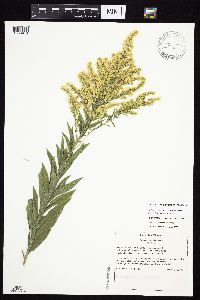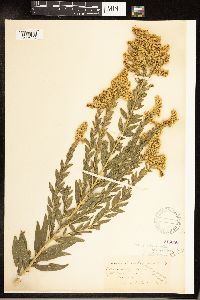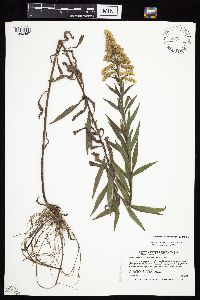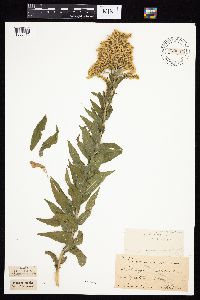Solidago altissima subsp. altissima
|
|
|
|
Family: Asteraceae
Tall Goldenrod
[Euthamia scabra Greene, moreSolidago scabra Muhl. ex Willd. non Muhl.] |
Involucres usually 3-4 mm. 2n = 36, 54. Flowering Aug-Oct. Dry to moist soils, fields, roadsides, disturbed areas; 0-1000+ m; Man., N.B., N.S., Ont., P.E.I., Que., Sask.; Ala., Ariz., Ark., Calif., Conn., Del., Fla., Ga., Ind., Iowa, Kans., Ky., La., Maine, Md., Mass., Mich., Minn., Miss., Mo., Nebr., N.H., N.J., N.Y., Ohio, Okla., Pa., R.I., S.C., Tenn., Tex., Utah, Vt., Va., W.Va.; Mexico. Subspecies altissima is an escaped cultivar or has been introduced in Arizona, California, and Utah, and very likely in other western states. It is the most common and 'weedy' member of subsect. Triplinerviae and has been introduced in many parts of the world. It replaces subsp. gilvocanescens in the eastern United States and adjacent Canada. Tetraploids are infrequent along the western edge of the subspecies´s distribution and rarely on glades in the southeastern United States. Hexaploids occur throughout the range. Array shape varies, narrower and elongate ones occurring in the southeastern United States; in Texas, such plants might be confused with Solidago juliae, which has more linear leaves. Further work is needed to analyze regional variants within each subspecies.
FNA 2006, Kearney and Peebles 1969, McDougall 1973 Duration: Perennial Nativity: Native Lifeform: Forb/Herb General: Herbaceous perennials, to 150 cm tall, stems 1-many, herbage pubescent throughout, plants with short to long-creeping rhizomes. Leaves: Alternate, lanceolate, acute or acuminate at the tips, margins entire or remotely toothed above the middle, faces rough to the touch with short, stiff hairs, undersides with gray pubescence, evidently 3-nerved, basal leaves absent, blades relatively thick and firm. Flowers: Heads small, numerous, radiate, rays yellow, 8-13, pistillate, to 1.5 mm long, disk flowers yellow, 3-6, perfect, involucres 3-4 mm high, narrowly campanulate, phyllaries linear, thin and dry with small, acute green tips and a prominent keel, unequal, overlapping in 3 series, heads 12-15, borne in pyramidal panicles, the heads arranged on one side of the axis only on numerous, recurved-spreading branches. Fruits: Achenes short, narrowly obconic, and pubescent-hirsute. Pappus of capillary bristles, 2.5-3.5 mm long. Ecology: Found on dry to moist soils, fields, roadsides, and disturbed areas, from 0-3,500 ft or more (0-1067 m); flowering July-October. Distribution: Arizona, California, and Utah, edge of Great plains eastward through the United States, northward in Canada to Nova Scotia and west to Saskatchewan, north of prairies. Ethnobotany: Compound poultice of the flowers was applied to burns, and ulcers and a poultice of moistened, pulverized roots was applied to boils. Etymology: Solidago comes from Latin solido, meaning to make whole or heal, while altissima means tallest. Synonyms: Solidago canadensis var. scabra, Senecio scabra, Senecio altissima var. altissima Editor: LCrumbacher 2011 From Flora of Indiana (1940) by Charles C. Deam This goldenrod is frequent to common in every county of the state. It prefers a moist rich soil but adapts itself to all kinds of soils and habitats. …… Indiana Coefficient of Conservatism: C = 0 Wetland Indicator Status: FACU |
























































































